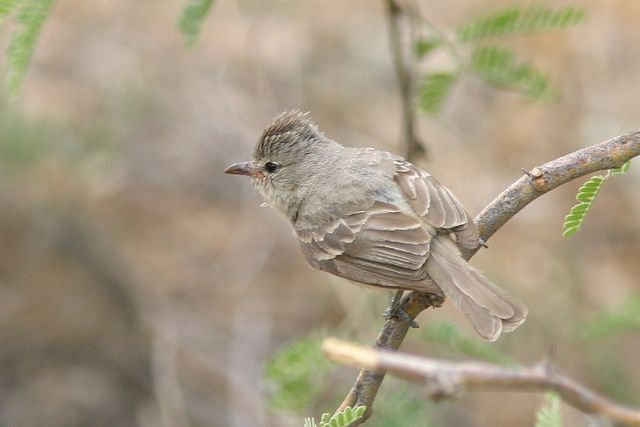
Once you eliminate the risque jokes (I know, I know, but it’s a family blog) the Northern Beardless-Tyrannulet might have the most comical name in American birding. How did this itty-bitty bird come to be saddled with a moniker that sounds exactly like a punchline about bird names? For once, the answer doesn’t lie in the ego of its discoverer or a folk interpretation of its call. To find out more, we must work backwards.
So, to start: Tyrannulet. A passing familiarity with suffixes is enough to guess that this means the bird is a small member of the tyrant flycatcher family (although not the smallest: that honor goes to the pygmy-tyrants). The tyrant flycatchers, in turn, derive their name from the first member of the family to land a Latin name, the Eastern Kingbird. As Kenn Kaufman points out in an August 2014 article for Birdwatching, it’s possible to envision that tyrant label sticking to the kingbird either on the basis of its bold behavior or its red crown. Kaufman seems to lean toward the behavioral explanation; Linneaus, in bestowing the name, relied on a description by Mark Catesby, and Catesby called the bird “The Tyrant” after observing its fearless and sometimes flagrant behavior towards larger birds. Other kingbirds and large flycatchers can also be quite aggressive; more retiring members of the family, like the tyrannulet, came along for the taxonomic ride. The tyrant name is now inseperable from flycatchers. The Northern Beardless-Tyrannulet itself was the Northern Beardless Flycatcher until the early 1980s.
Next: Beardless. Like the red in Red-bellied Woodpecker and the ring in Ring-necked Duck, this part of the Northern Beardless-Tyrannulet’s name describes a feature that is not obvious to the casual observer or from a great distance. In this case, it refers to the bird’s lack of rictal bristles. Such bristles, small hairlike feathers around the base of a bird’s beak, are found on most flycatchers as well as a wide range of other species from eagles to nightjars. While the location of the bristles suggests that they may have something to do with a bird’s feeding habits, their exact function is not fully established. At any rate, the Northern Beardless-Tyrannulet seems to get by fine without them.
Which brings us to Northern. There is no great mystery here. There was only a Beardless-Tyrannulet (or Flycatcher) until someone noticed that Costa Rica contained two similar but distinct, non-interbreeding populations of the birds. The result was another in a long line of glorious taxonomic decisions that led to less than glorious naming decisions — the good old bland geographic descriptor that adds nothing but syllables to a name that doesn’t really need more.
Finally, a few additional notes. The question of the hyphen in the name Beardless-Tyrannulet is, of course, a vexed one. I’m using the hyphen here to match with the master beat writers’ year list, and thus indirectly to align with eBird. Please do not yell at me. Also, in the course of my research I came across a website claiming that the collective noun for a group of Beardless-Tyrannulets is a “shaving”, but out of simple decency I will conceal their shame.
Featured image courtesy of Marcel Holyoak under a Creative Commons license.













“the good old bland geographic descriptor that adds nothing but syllables to a name that doesn’t really need more.” – Love that and the “shaving” of those nondescript birds. Although both species are pretty common in Costa Rica they seem to occur as hairless bits rather than shavings.
Thanks! I really couldn’t believe that someone would try to coin such a silly collective noun.